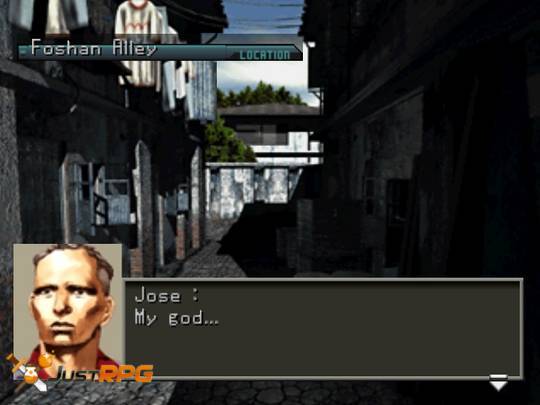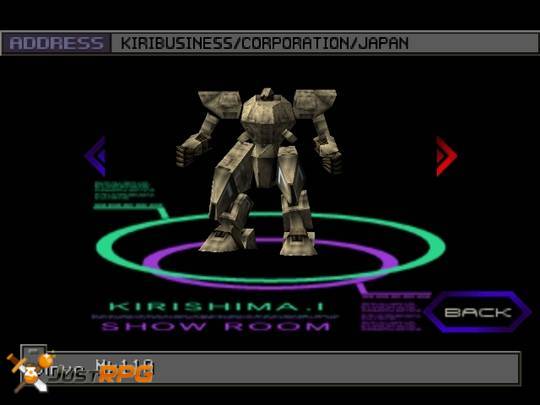Front Mission 3
Front Mission 3 is a strategy RPG where players take control of giant robots as they fight a war.
| Developer: Squaresoft Publisher: Squaresoft Release Date: March 21, 2000 Platforms: Playstation JustRPG Score: 90% Pros: +Appealing Characters. +Great Dialogue +Addictive Cons: -Weird Battle system |
Front Mission 3 Overview
Front Mission 3 is a tactics style role playing game that was released for the Sony Playstation 1 in late 1999. Players control robots known as wanzers through multiple story lines. This linear role playing game has heavy emphasis on its role playing elements and less on strategy compared to other Front Mission games. Players will watch a cut scene, prepare their mecha for battle, and then enter the tactics style missions. As players complete missions on the world map more will pop up until they beat the game. Although the combat is very similar to the other Front Mission games players are now able to attack the pilots of the mecha themselves.
Front Mission 3 Screenshots
Front Mission 3 Featured Video
[youtube]http://www.youtube.com/watch?v=cVJ06R8Mk98[/youtube]
Front Mission 3 Review
When I first picked up this game, I was overjoyed that it had a similar battle system to one of my favorite Square games, Final Fantasy Tactics. It’s an odd way the game came into my possession, however, because I did not buy it, nor did anyone in my family. Sounds kind of creepy, just appearing out of thin air, but I am sure glad that it did!
What turned off most of my friends from playing Front Mission 3 was its battle system. Now, I am not sure how most people would react to it, since it’s different from most RPGs. FM3 is a turn-based strategy/RPG that plays on board (think chess, but with robots, called Wanzers, and different elevations). Your units move from space to space until you reach an enemy, and then you attack. Sounds simple enough, right? Unfortunately, it’s not. You have a limited amount of AP, or Action Points, that you use to do all your basic actions, such as: moving, attacking, defending or counter-attacking, use items, and bailing out of your Wanzer. Planning how you use your AP is your key to victory. For example, you can choose to move all the way up to an enemy and attack him with a close range attack, wasting all your AP (which is normally more accurate and powerful than a long range attack). If you choose to stay put and use a long-range attack, leaving some AP left, you can save that AP for your enemy’s turn, so you can potentially counter-attack should they attack you. The damage system in Front Mission 3 is a unique one, focusing on parts rather than one whole health bar. Your Wanzer, and your enemy’s, has 5 different parts where it can be damaged: Arms, Legs, Pilot, and Body. Damage to parts is usually random, except for certain situations, and can sometimes hit the pilot, who is normally protected by the body. In addition to damage, status effects can fall upon your Wanzer, like confused or stunned. Once a part’s health bar goes to 0, that part is destroyed for the battle (whew), which means you cannot use it (duh). Having your Wanzer’s body destroyed means the end of the Wanzer for the battle (the same goes with your pilot’s health), which you can prevent slightly by using items or bailing out of the Wanzer, which takes AP, so you can only do that during your turn. Bailing out of your Wanzer means your pilot is exposed and has to fight giant robots, armed only with a pistol, until he can find a suitable host (i.e. an enemy’s Wanzer, which was bailed out of). The damage system for the pilot is the same, but he only has one health bar, and is seemingly invincible. The reason why these menacing pilots are so invincible is because you can barely hit them with weapons, and the weapons that normally would do, say 35 damage to a wanzer, would only do 1-3 points to your pilot, rather than killing him. Moving on, throughout the game you can purchase new parts either through stores or “online,” using the game’s Network (basically like the Internet). Like most RPGs, most new parts have high armor class, and HP rating, along with modifies that can improve weapon skills and prevent damage by certain types of attacks. The most important feature, and most mundane, is the micromanaging of your Wanzer’s power source, which is determined by the body you choose. For each part you add to your Wanzer, a certain amount of power is subtracted, after that you have to figure in your backpack and the weapons you use. This prevents players from making the biggest, strongest Wanzer available that is nigh-invincible, but at the same time frustrates some people who have to search for the right part. Getting the right part so your power level does not go into the negative (meaning your Wanzer is not moving) usually means downgrading another part to upgrade another part. Using weaker parts is usually a must for completists because each part gives you a certain ability, which your pilot can learn and use in battle, such as using both arms in a single attack or even targeting specific parts. One last feature during battle is the option to save at any point in the battle, making it possible to skip all the things you have already done, should you lose.
FM3’s story is simple enough. You are Kazuki Takemura, a Wanzer test pilot for Kirishima Industry. Kazuki and his friend, Ryogo Kusama end up getting involved in a worldwide fiasco that surrounds a new weapon called MIDAS. Along the way Kazuki befriends a scientist, named Emir Klamsky, who originally developed MIDAS, and who was trying to stop it from getting into the wrong hands, since it was stolen. The game has two story lines. The jist of the story is Kazuki and Ryogo stumbling upon the weapon MIDAS when it is being tested, and they travel the world trying to save Alisa and the world from the devastating weapon (MIDAS is best thought of as a nuke, but rather than exploding it creates a large sphere that disintegrates everything that it touches). Thankfully, Square put in the Network system that explains a lot of the background of the Front Mission universe.
I can normally stand ugly graphics, and boy does FM3 have some. The battlefields in FM3 are especially grainy (pixilated) and feature some 2D objects. They do a good job at making the environment recognizable, whether it’s a base or a city. Most of the battlefields have destroyable objects, like trees and cars. FM3’s Wanzers are, however, much better than the environments and their animations are what you would expect a giant robot to look like when it moves. Every so often, players are treated to a FMV sequence. Like anything, there are some good ones and some bad ones, but most look good.
The sound was especially good in the sound effects side. From explosions to clashing of metal, the sounds were near perfect. On the other side, the music in FM3 was not that great, even though you tend to mentally block it out during battle.
Although it is hard to believe, Square promised that FM3 would provide up to 150 hours of enjoyment. Most of that time, however, would be allocated to navigating the Network, rather than actual gameplay. Regardless, FM3 does provide two stories, when one is finished you can start the other using your already awesome characters. There is no multiplayer mode in FM3. The Network is basically your extras for the game, since it contains most of the game’s secrets and other things, like voting for Alisa to be Miss Teihoku.
Front Mission 3 Screenshots
Front Mission 3 Videos
[youtube]http://www.youtube.com/watch?v=cVJ06R8Mk98[/youtube]











